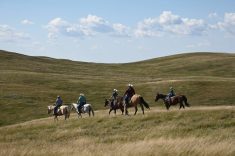Dairy cattle love it, dairy nutritionists hate it and dairy producers often feed it.
When hay is baled or stacked at moistures above 18 per cent, it can create a favourable environment for mould growth. As moulds thrive in moist hay, they generate a lot of heat, which under the right conditions may caramelize different essential dairy nutrients together. As a result, it creates sweet-smelling caramel-coloured hay that is consumed by dairy cows with exceptional vigour, but is not particularly safe or nutritious. Dairy producers who feed caramelized hay should take samples for mould and nutrient testing and make the necessary nutrient adjustments to diets to ensure health and production of dairy cattle is never compromised.
Read Also

Harvest wraps up and fall work begins
At the Eppich famly ranch in western Saskatchewan, the fall harvest was successful with few breakdowns, cows and calves have been sorted and a new tractor has arrived
Caramelized heat-damaged hay undergoes adverse nutrient transformation in an aerobic process known as the “Browning reaction,” which often occurs when the temperatures of the poorly cured hay reaches 60 C (140 F). It is a non-enzymatic reaction, which binds the heated forages’ carbohydrates and proteins together, and thus renders a large portion of dietary proteins unavailable to dairy livestock. If left unchecked, a Browning reaction of hay can also lead to spontaneous combustion and devastating bale fires (probed temperatures of about 82 C (180 F)).
Determine protein
Luckily, most heated-hay bales won’t burst into flames, but when dairy producers open some of these bales, they might see brown caramelization, which can be an unmistakable sign for possible damage to its protein content. In order to measure the extent of protein rendered unusable by heating, producers should take the appropriate forage samples and request an ADIN (acid detergent insoluble nitrogen) analysis at a feed-testing laboratory.
Once this ADIN result is sent back, producers can get a good idea as to the ADF-CP (re: measure of crude protein unavailable to the dairy animal) and the ACP (re: adjusted crude protein, available for animal production, which is calculated when the ADF-CP is greater than 10 per cent of the tested CP in forage samples).
Consider an example of a caramelized alfalfa-grass forage sample reporting an 18 per cent protein and ADIN of 0.62 per cent. To calculate its final ACP it is a simple matter of using the following three-step calculations:
1.ADF — CP from ADIN: ADIN% x 6.25 or 0.62 x 6.25 = 3.9 per cent
2.ADF-CP as a % of total forage CP: 3.9/18 x 100 = 21.7 per cent
3.ACP = CP% x [100 — (ADF-CP% – 10%)]: 18 x [100 — (21.7 — 10)] or 15.9 per cent
The final calculation yields an ACP of 15.9 per cent as the new protein value of this alfalfa-grass mixture compared to the original value of 18 per cent. It is the new ACP value that should be used when formulating this particular caramelized hay in a dairy diet (assume all values in the forage sample are based on a dm, basis).
Recommendations for damaged goods
Keep in mind this is still heat-damaged hay. Regardless of what salvageable forage dietary proteins it contains; the main goal is to feed caramelized hay without damaging the health and performance of dairy cattle. Here are some suggestions when dealing with a caramelized heat-damaged hay:
- Do not feed mouldy heat-damaged hay — Discoloured caramelized hay often has white patches of mould interlaced between the stems and leaves. Mould significantly reduces the energy and protein content of forages as well as forage digestibility. Mycotoxins produced by forage moulds will likely compromise cattle health and performance.
- Limit-feed mould-free, heat-damaged hay — If laboratory-confirmed it is safe to feed (mycotoxin tests) and ACP adjustments to the ration can be made. Formulate a small ground portion of this compromised forage into the overall dairy diet (such as a total mixed ration). Maximize the amount of silage or better quality hay fed, given your total forage inventory and mix it with small amounts of caramelized forage.
- Sort your total hay inventory according to quality — Save the best hay for high milk-producing dairy cows. Feed caramelized forage in a balanced diet to loafing animals such as faraway dry cows and replacement heifer stock. As mentioned, avoid feeding any mouldy forage to any dairy livestock.
- Use as a dietary straw replacement — In many cases 1/2 to one kilo of cereal straw are added to lactation diets to slowdown the rate of feed passage in milking cows. Similar amounts of mould-free caramelized hay might be incorporated into high producing lactation diets for the same reasons.
- Feed only to growing-finishing dairy steer diets — For similar reasons as a straw substitute, incorporate 10 to 15 per cent of mould-free/heat-damaged (tested) forage in backgrounding dairy steer diets. It would replace straw or low-quality forages that are commonly formulated in these diets.
- Look into buying better-quality hay — Calculate the economic consequences of buying higher-quality forages compared to compromising milk production by feeding poor heat-damaged hay. Unfortunately, in a wet Prairie summer good quality hay is usually hard to find.
Nobody advocates the widespread feeding of caramelized heat-damaged hay to dairy cattle, however if you have it, it can be managed to be safely fed. It should never be a total replacement for high-quality hay for dairy cattle. But can be used in limited amounts by following the recommendations. †















